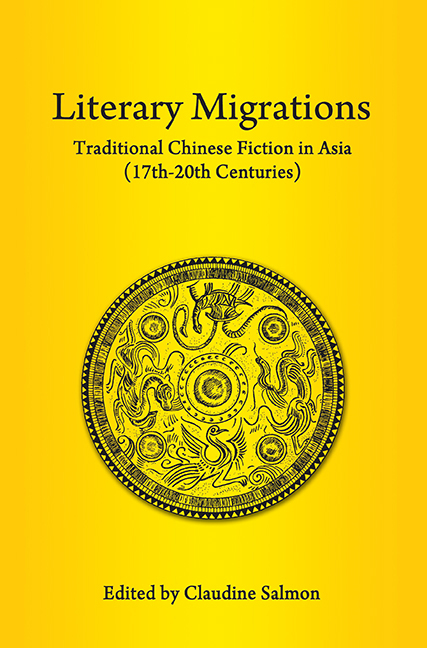Book contents
- Frontmatter
- Contents
- FOREWORD
- Dr Salmon as I Know her
- Preface to Reprint Edition
- Acknowledgements
- INTRODUCTION
- PART I KOREA AND JAPAN
- PART II MAINLAND NORTHEAST ASIA
- PART III MAINLAND SOUTHEAST ASIA
- 7 The Influence of Chinese Fiction on Vietnamese Literature
- 8 Thai Translations of Chinese Literary Works
- 9 Chinese Literary Influence on Cambodia in the Nineteenth and Twentieth Centuries
- PART IV INSULAR SOUTHEAST ASIA
- Bibliography
- Author, story-teller and translator index
- Title index
- List of Plates
- Contributors
- Plate section
9 - Chinese Literary Influence on Cambodia in the Nineteenth and Twentieth Centuries
from PART III - MAINLAND SOUTHEAST ASIA
Published online by Cambridge University Press: 21 October 2015
- Frontmatter
- Contents
- FOREWORD
- Dr Salmon as I Know her
- Preface to Reprint Edition
- Acknowledgements
- INTRODUCTION
- PART I KOREA AND JAPAN
- PART II MAINLAND NORTHEAST ASIA
- PART III MAINLAND SOUTHEAST ASIA
- 7 The Influence of Chinese Fiction on Vietnamese Literature
- 8 Thai Translations of Chinese Literary Works
- 9 Chinese Literary Influence on Cambodia in the Nineteenth and Twentieth Centuries
- PART IV INSULAR SOUTHEAST ASIA
- Bibliography
- Author, story-teller and translator index
- Title index
- List of Plates
- Contributors
- Plate section
Summary
Although considered to be one of the jewels of Further India, Cambodia has been influenced by China in a variety of ways: through Chinese immigration and the spread of techniques as well as in a way that can broadly be described as “cultural”. Naturally, the Cambodian language has recorded this penetration, for example by absorbing several hundreds of words of Chinese origin. One would therefore expect to find the stamp of a similar influence upon Cambodian literature. Yet, paradoxically, this influence on classical literature can barely be perceived through “hints and guesses”. For, although they are clearly discernible in the Cambodian texts, the themes of the Chinese merchant and of Chinese political power appear to reflect social and political realities rather than trends in inspiration or literary sensibility.
Given the state of research on the subject today, the traces of Chinese literary influence, if indeed they must be sought, can only be found either in a handful of little-known manuscripts dating from not earlier than the mid-nineteenth century, or else in a regional (in a sense, foreign)and short-lived genre of popular theatre that sprang up a few decades later.
In fact, it is only in the 1960s that the Chinese influence can unmistakably be seen to be direct, explicit and meaningful. This influence was then all the more palpable as it was found in popular-priced books, serialized novels and comics, that is to say, in literature of the liveliest and most widely read variety. Moreover, in contrast to the meagreness in the number of “Chinese-inspired” works published in earlier times, the output of the sixties was abundant and varied, and increasingly well received. Yet, and here is another paradox, specialists of contemporary Cambodian literature have rather ignored this class of literature while paying attention, for example, to the products of the French influence on Cambodian literature.
Our purpose here, therefore, is to return to the question by summing up what is known about the contribution of the Chinese influence to the development of Cambodian literature. We shall first describe the situation in the nineteenth century, then pinpoint the emergence of a Chinese-inspired literature during the first half of the twentieth century, and finally examine the contemporary wave of Chinese influence.
- Type
- Chapter
- Information
- Literary MigrationsTraditional Chinese Fiction in Asia (17th–20th Centuries), pp. 199 - 232Publisher: ISEAS–Yusof Ishak InstitutePrint publication year: 2013

